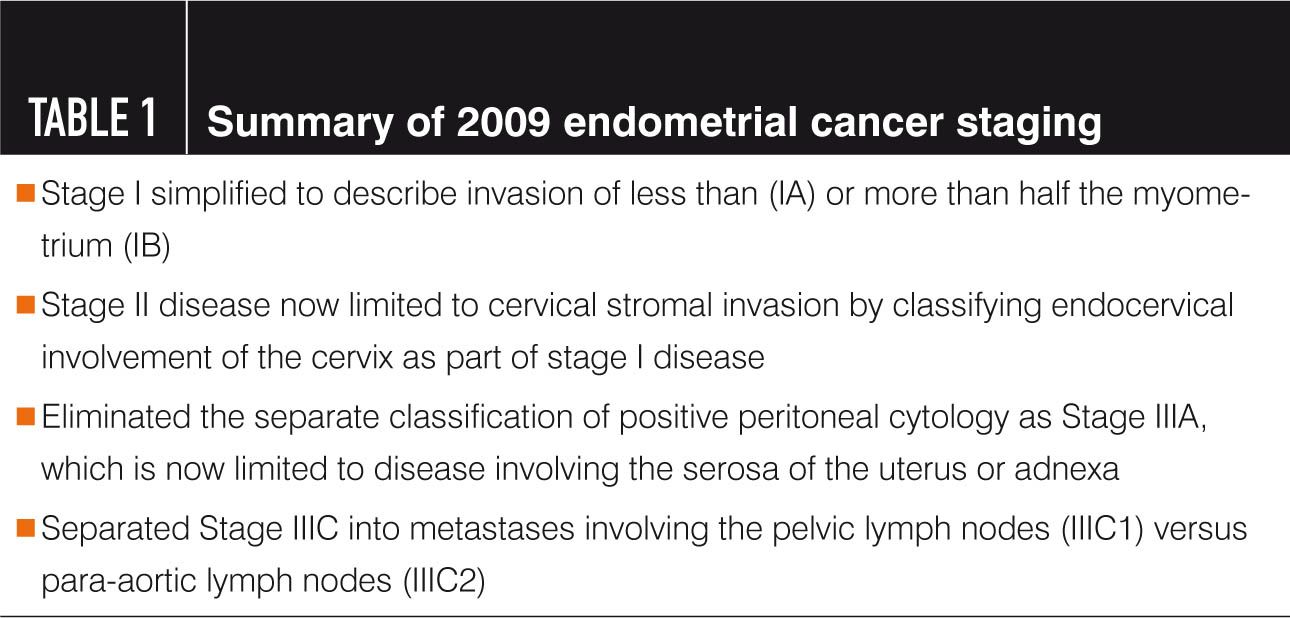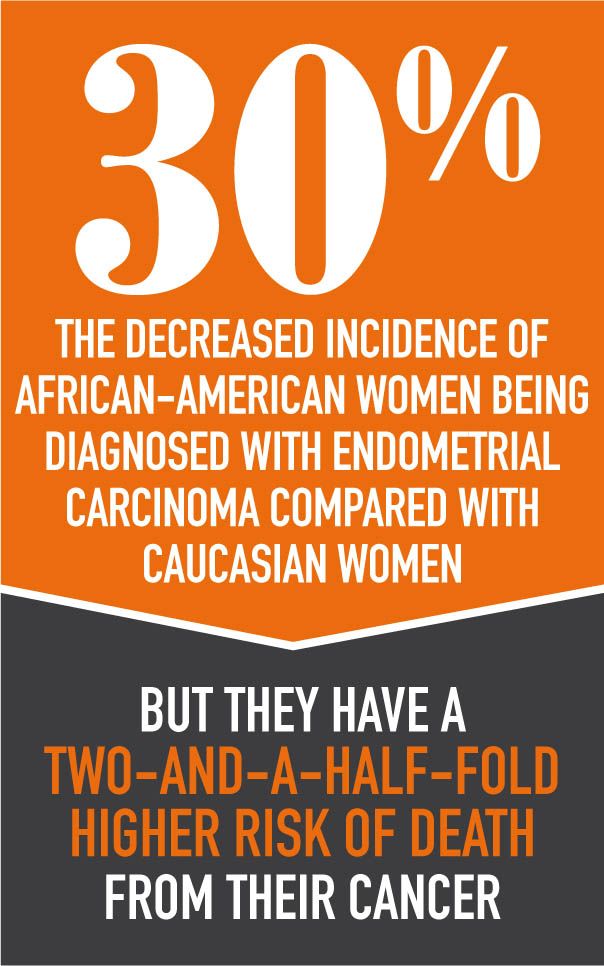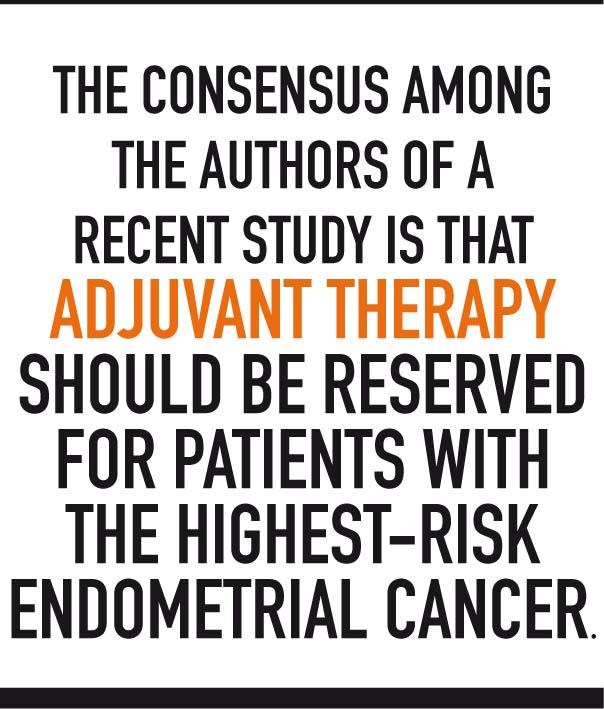ACOG Guidelines at a Glance: Endometrial Cancer
A commentary on ACOG Practice Bulletin Number 149: Endometrial Cancer
Committee on Practice Bulletins-Gynecology and the Society of Gynecologic Oncology.
ACOG Practice Bulletin Number 149: Endometrial Cancer. April 2015. Obstet Gynecol 2015;125:1006-26. Full text of ACOG Practice Bulletins is available to ACOG members at www.acog.org/Resources-And-Publications/Practice-Bulletins/Committee-on-Practice-Bulletins-Gynecology/Endometrial-Cancer
Endometrial Cancer
Endometrial carcinoma is the most commonly diagnosed gynecologic malignancy: almost every gynecologist will encounter it. A thorough understanding of the epidemiology, pathophysiology and diagnostic and management strategies for this type of cancer allows the obstetrician-gynecologist to identify women at increased risk, contribute toward risk reduction, and facilitate early diagnosis. The purpose of this document is to review the current understanding of endometrial cancer and to provide guidelines for management that have been validated by appropriately conducted outcome-based research when available. Additional guidelines on the basis of consensus and expert opinion also are presented.
Used with permission. Copyright the American College of Obstetricians and Gynecologists.
Endometrial cancer 2005-2015

By Ilana Cass, MD
Dr. Cass is Vice Chair and Associate Clinical Professor, Department of Obstetrics and Gynecology, Cedars-Sinai Medical Center, Los Angeles, California. She is also a member of the Contemporary OB/GYN editorial board.
Practice Bulletin #149, published in April, 2015, replaces Practice Bulletin 65, published in 2005. This commentary broadly discusses endometrial cancer using Practice Bulletin 149 as a source. The new guidelines reflect current understanding of genetic causes of and risk factors for endometrial cancer. The new Practice Bulletin expands upon contemporary management to include level “A” recommendations regarding the appropriate evaluation of abnormal uterine bleeding to optimize detection and describes appropriate preoperative evaluation. A new surgical staging system was adopted in 2009 to better reflect the behavior of endometrial cancer and align treatment planning. The Practice Bulletin endorses the use of minimally invasive surgery to stage and treat endometrial cancer, which has now been validated in large, prospective trials to dramatically reduce the morbidity of surgery. The Practice Bulletin reflects the ongoing controversy about adjuvant therapy and offers important consensus opinions regarding the appropriate surveillance of endometrial cancer patients after treatment to improve quality of life.

Expanded risk factors
The epidemic of obesity in the United States has resulted in an increased incidence of endometrial cancer. A recent meta-analysis of more than 40 studies involving 32 million women found that body mass index (BMI) was strongly associated with risk of endometrial cancer. Overweight women (BMI 25–29.9 kg/m2) and obese women (BMI > 30 kg/m2) had an estimated odds ratio (OR) of developing endometrial cancer of 1.43 (95% CI: 1.30–1.56) and 3.33 (95% CI: 2.87–3.79) respectively, compared to normal-weight women.1 Estrogen, whether derived from endogenous sources like excess adipose tissue or from exogenous sources including unopposed estrogen therapy, is associated with type I endometrial cancer in a dose-dependent relationship. While this risk is offset by concomitant progestins, the optimal dose and length of progestin therapy remains unclear. Intermittent dosing of oral progestins (< 10 days per month) or the variable absorption seen with topical progestin creams increases the risk of endometrial cancer, whereas continuous regimens including that obtained from the intrauterine levonorgestrel-releasing intrauterine system (IUS) decrease the risk.2 Based upon this compelling data, the use of prophylactic progestins in women at the highest risk of developing endometrial cancer has been advocated. 3
Genetic predisposition
Increased awareness of the strong association between personal and family history and inherited predisposition to gynecologic cancers has led to more frequent genetic testing. Lynch syndrome (formerly known as hereditary non-polyposis colorectal cancer) is the most common hereditary cause of endometrial cancer, responsible for 2% to 3% of all cases and up to 10% of endometrial cancer diagnoses in women younger than age 50.4
Endometrial cancer is the sentinel cancer among women with Lynch syndrome, an autosomal-dominant condition that results from germline mutations in DNA mismatch repair genes including MLH1, MSH2, MSH6, and PMS2, which are responsible for recognizing and repairing errors in DNA replication.5 Mutations in DNA mismatch repair genes result in accumulated somatic mutations, which increase the risk of many cancers including those of the endometrium, ovary, colon, hepatobiliary system, brain/central nervous system, small bowel, and urinary tract, as well as sebaceous tumors. Cowden's syndrome, a rare autosomal-dominant condition caused by PTEN mutations, is also associated with an increased risk of endometrial cancer. Recent consensus guidelines have proposed more liberal genetic testing of women with endometrial cancer, even in the absence of a strong family history, to reduce the morbidity and mortality from other cancers related to this syndrome.4,6 Increased access to genetic testing using available next-generation sequencing techniques, which study multiple genes simultaneously, may potentially reveal gynecologic cancer risks associated with other genetic mutations.7
A concomitant increase in the number of deaths from endometrial cancer has been reported, that is not entirely attributable to the increase in obesity-related type I endometrial cancers, which generally carry a better prognosis. Emerging data suggest that significant healthcare disparities are largely responsible for the poorer prognosis observed in some women despite similar disease characteristics. African-American women, older women, and those from rural demographic settings have worse outcomes, even when adjusted for the frequency of the more aggressive, type II endometrial cancers. A recent systematic review of 24 studies of more than 366,000 cases of endometrial cancer found that African-American women had a 30% decreased incidence of being diagnosed with endometrial carcinoma compared with Caucasian women, but a two-and-a-half-fold higher risk of death from their cancer. The authors suggest that aggressive histology and socioeconomic factors largely drive these differences.8 To date, no clear hormonal or reproductive risk factors have been linked to type II endometrial cancers. Health care disparities remain an area of active research in order to improve outcome for the treatment of endometrial cancer.
Diagnosing endometrial cancer
The Practice Bulletin endorses transvaginal sonography (TVS) or outpatient histologic evaluation of the endometrium with a disposable device as equally acceptable methods for initial assessment of women with postmenopausal bleeding. An endometrial thickness >5 mm seen on TVS in postmenopausal women with bleeding has shown high rates of sensitivity in the detection of endometrial cancer and mandates histologic evaluation. Level A recommendations support the addition of hysteroscopy at the time of dilation and curettage (D&C) to fully evaluate the endometrial lining and exclude a premalignant or benign lesion as the cause of bleeding or endometrial cancer.
Updates in surgical staging
Staging of endometrial cancer was updated in 2009, 2 decades after the system was initially described. The mainstay of treatment for endometrial cancer is surgical removal of the uterus, cervix, ovaries, and fallopian tubes. The update in 2009 better aligns histopathologic findings with prognosis. Review of data from more than 42,000 women with endometrial cancer by FIGO allowed for analysis of specific prognostic factors in surgico-pathologic staging. The FIGO committee simplified the 1988 staging classification by combining some substages that had a similar prognosis and segregating others that were believed to have a distinct prognosis.9,10 Highlights of the updated 2009 surgical staging of endometrial cancer are shown in Table 1.

Randomized clinical trials have established that minimally invasive surgery is appropriate and the preferred staging approach for endometrial cancer. Minimally invasive surgery has been associated with improved recovery times and decreased length of stay and postoperative complications.11 Newer studies have described other minimally invasive techniques, including use of the robot and single-incision ports, in addition to standard laparoscopy, with promising results. The differences in patient selection, operator experience, and increased cost of these techniques limit any definitive conclusions. These technologies may expand the number of patients with endometrial cancer who would be candidates for minimally invasive surgery.
The role of routine lymphadenectomy in women with endometrial cancer remains controversial, as no randomized trial has shown a survival benefit from lymphadenectomy that may relate to the preponderance of early-stage disease confined to the uterus.12 Although women with low-grade, minimally invasive disease do not appear to benefit from routine lymphadenectomy, no definitive pre- or intraoperative predictors exist that can reliably identify them. Consequently, preoperative consultation with a gynecologic oncologist is recommended, especially in the context of preoperative high-risk features or limited intraoperative ability to either assess the extent of uterine disease or adequately stage the patient’s disease. Endometrial cancer is considered high-risk if it is grade 2 or 3 disease, there is evidence of clear cell or papillary serous histology, or any clinical or radiologic suspicion of cervical or extrauterine disease, and when it is diagnosed in a woman with a family history of the disease.

Comprehensive staging of women with high-risk disease improves the diagnostic accuracy of surgery and prognosis, and allows for better tailoring of treatment recommendations. Comprehensive staging reduces unnecessary treatment and its related morbidity. A study of 714 women with early-stage uterine cancer found that women treated with pelvic radiation had higher rates of urinary and bowel symptoms resulting in lower physical function up to 15 years after completion of treatment.13 A subsequent prospective trial of 560 women with early-stage endometrial cancer showed that treatment with a combination of vaginal and pelvic radiation was associated with higher rates of secondary malignancies than was treatment with vaginal radiation alone.14 A recent pooled study of more than 1,200 women with endometrial cancer did not find an increased risk of developing a second cancer among those treated with pelvic radiation after a median of 13 years.15 The consensus among the authors is that adjuvant therapy should be reserved for patients with the highest-risk endometrial cancer.
Surveillance of women with endometrial cancer
Consensus guidelines from both the Society of Gynecologic Oncologists and the National Comprehensive Cancer Network for post-treatment surveillance of women with endometrial cancer emphasize improving healthcare delivery and outcomes by limiting unnecessary imaging in asymptomatic cancer patients. Routine vaginal cytology and annual chest radiography are not recommended in the low-risk patient, given the limited ability to detect asymptomatic recurrences.

Provocative data suggest that cardiovascular disease is associated with the greatest risk of mortality in women with the most common endometrial cancer, type 1 disease. Therefore, gynecologists who care for obese women with endometrial cancer are in a unique position to use the diagnosis and treatment of endometrial cancer as an opportunity to modify healthcare behaviors. A small randomized, controlled trial provides level I evidence that weight loss and exercise programs may improve the overall survival and quality of life for women following treatment of endometrial cancer.16 Interventions designed to reduce non-cancer health risks for women successfully treated for endometrial cancer may be the most effective way to affect their survival.
References
1. Jenabi E , Poorolajal J. The effect of body mass index on endometrial cancer: a meta-analysis. Public Health. 2015; doi:10.1016. [Epub ahead of print].
2. Jaakkola S, Lyytinen HK, Dyba T, Yikorkala O, Pukkala E. Endometrial cancer associated with various forms of postmenopausal hormone replacement therapy. Int J Cancer. 2011;128:1644–1651.
3. Lu KH, Loose DS, Yates MS, et al. Prospective multicenter randomized biomarker study of oral contraceptive versus depo-provera for prevention of endometrial cancer in women with . Lynch syndrome. Cancer Prev Res. 2013;6:774–781.
4. SGO Clinical Practice Statement: Screening for Lynch Syndrome in Endometrial Cancer SGO (2014) https://www.sgo.org/clinical-practice/guidelines/screening-for-lynch-syndrome-in-endometrial-cancer/.
5. Lu KH, Dinh M, Kohlmann W, et al. Gynecologic cancer as a “sentinel cancer” for women with hereditary nonpolyposis colorectal cancer syndrome. Gynecol Oncol. 2005;105:569–574.
6. Batte BA, Bruegl AS, Daniels MS, et al. Consequences of universal MSI/IHC in screening endometrial cancer patients for Lynch syndrome. Gynecol Oncol. 2014;134(2):319–325.
7. Walsh T, Casadei S, Lee MK, et al. Mutations in 12 genes for inherited ovarian, fallopian tube, and peritoneal carcinoma identified by massively parallel sequencing. Proc Natl Acad Sci. 2011;108:18032–18037.
8. Long B, Liu FW, Bristow RE. Disparities in uterine cancer epidemiology, treatment, and survival among African Americans in the United States. Gynecol Oncol. 2013;130(3):652–659.
9. Pecorelli S. Revised FIGO staging for carcinoma of the vulva, cervix, and endometrium. Int J Gynaecol Obstet. 2009;105(2):103.
10. Creasman W Revised FIGO staging for carcinoma of the endometrium. Gynecol Oncol. 2009;105:109.
11. Walker JL, Piedmonte MR, Spirtos NM, et al. Recurrence and survival after random assignment to laparoscopy versus laparotomy for comprehensive surgical staging of uterine cancer: Gynecologic Oncology Group Lap2 Study. J Clin Oncol. 2012;30(13):1570.
12. Benedetti-Panici P, Basile S, Maneschi F, et al. Systematic pelvic lymphadenectomy vs. no lmphadenetcomy in early stage endometrial cancer:randomized clinical trial. J Natl Cancer Inst. 2008;100:1707-1716.
13. Nout RA, van de Poll-Franse LV, Lybeert ML, et al. Long-term outcome and quality of life of patients with endometrial carcinoma treated with or without pelvic radiotherapy in the post-operative radiation therapy in endometrial carcinoma 1 (PORTEC-1) trial. J Clin Oncol. 2011;29(13):1692–1700.
14. Onsrud M, Cvancarova M, Hellebust TP, et al: Long-term outcomes after pelvic radiation for early-stage endometrial cancer. J Clin Oncol. 2013;31:3951–3956.
15. Wiltink LM, Nout RA, Fiocco M, et al. No increased risk of second cancer after radiotherapy in patients treated for rectal or endometrial cancer in the randomized TME, PORTEC-1, and PORTEC-2 trials. J Clin Oncol. 2015;33:1640–1646.
16. von Gruenigen VE, Frasure HE, Kavanagh MB, et al. Survivors of uterine cancer empowered by exercise and healthy diet (SUCCEED): a randomized, controlled trial. Gynecol Oncol. 2012;125:699–704.
